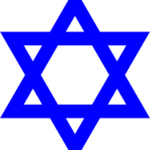
Star of David symbol
| Symbol | Star of David |
| Religion | Judaism |
| Origin | Historical debates surround its exact origin; gained prominence in the late Middle Ages |
| Meaning | Represents the connection between God and the Jewish people, formed by overlaying two equilateral triangles. |
| Appearance | Six-pointed star created by the intersection of two triangles. |
| Colors | Varied, but commonly depicted in blue and white. |
| Usage | Widespread use in Judaism, appearing on synagogues, flags, and religious texts. |
| History | Rich history with references dating back centuries, symbolic importance in Jewish culture. |
| Popularity | Widely recognized and utilized, both within and beyond the Jewish community. |
| Importance | Cultural emblem for Jewish identity, symbolizing faith, heritage, and unity. |
| Complexity | Simple geometric design, yet carries deep historical and religious significance |
| Emotions | Evokes a range of emotions tied to Jewish identity, faith, and historical resilience. |
The Star of David: A Complex Symbol of Judaism and Identity
The Star of David, also known as the Magen David in Hebrew, is a six-pointed star widely recognized as a symbol of Judaism and Jewish identity. While its exact origins remain unknown, it has evolved over centuries to hold deep significance for the Jewish people.
Key points:
- Shape: Two equilateral triangles overlaid, forming a hexagram.
- Significance: Represents Judaism,Jewish identity, and the State of Israel.
- History: Usage predates the 3rd century, but widespread adoption as a Jewish symbol came later.
- Modern Use: Found on synagogues,Judaica objects, the Israeli flag, and Magen David Adom (Israeli Red Cross).
- Symbolism: Varies depending on context, but can represent God’s protection, creation, unity, and more.
- Important Note: The Star of David’s meaning can be sensitive, and its use outside the Jewish community should be done with respect and understanding.
Additional Notes:
- The Star of David is not mentioned in the Bible or Talmud, and its association with King David is likely a later development.
- During the Holocaust, the Nazis forced Jews to wear the Star of David as a badge of identification, imbuing it with a powerful symbol of resilience and resistance.
- Today, the Star of David remains a powerful symbol for many Jews, but its interpretations and uses can vary widely.